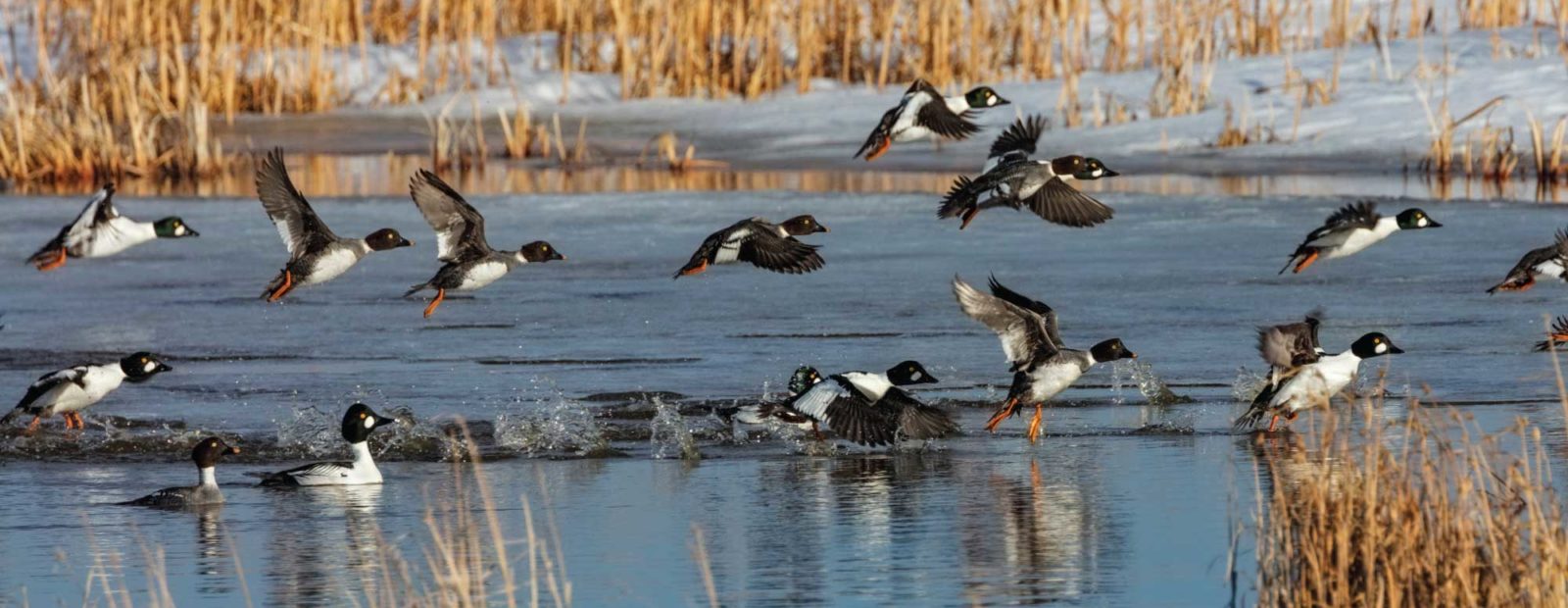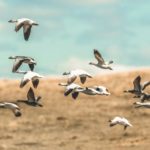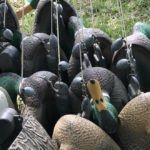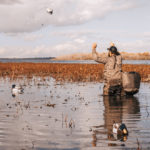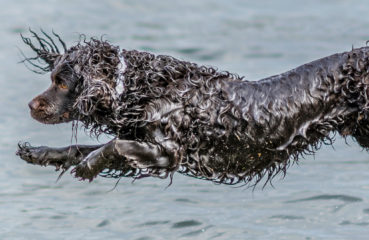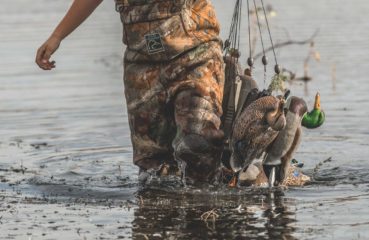Teaming up on elusive white whistlers on an accessible hunt
There is a certain calm that comes after a blizzard that’s unlike any other. Stilling silence covered the land in such a way that as soon as I took my first breath to lock my front door behind me, I knew what had happened overnight without even looking. A blizzard’s aftermath chills to the bone, and in turn, grips the soul.
It’s introspective for all living things; a hard night was endured. Reprieve comes by a stilling sigh. The sounds of life slowly awaken with a tattered oak leaf breaking away from its mighty tree — an act so delicate, yet amplified by the silence as it crashes down through the tangled understory below. Every creature in a mile-wide radius hears it. Surely the entire county knew when The Legend and I rummaged through the slush and heavy snow in our trucks as we made way down the dirt road that dark, whitened morning.
The Setup
The pre-shooting-light itinerary was as packed as the snow below our waders. We were setting up for a day of hunting with a group of hunters with disabilities, who would soon be arriving and ready to take their places in the blinds. First we’d tackle The Creek with a weather-sheltered spread of a couple dozen floating mallard decoys, a dozen full bodies along the sand bars, and a vortex near the kill hole. The goal was to give the impression of birds cozying up with their other fake, mallard kin.
Next agenda item: high-tail it a half mile east to the main body of the lake to put out an entirely different spread for yet another group of hunters, also with disabilities. Goldeneyes had finally come down in full wintering numbers, and there was no way we’d miss going after these near-mythical birds of the north.
A decoy raft of six goldeneyes would be the focal point of the spread with two mini long-lines of a half dozen goldeneyes branching off the raft in a “V.” Accented behind the raft, to serve as a final blocker, were six black duck blocks paired off loosely. They angled toward a dozen mallards huddled in a small bay next to a giant, fallen cottonwood that gave the impression of them taking shelter from the forecast winds from the east. The Legend was wrapping up the finishing touches on them as I made haste with a small pod of six buffleheads — placed in between the raft of goldeneyes and the shore to lure in the more indiscriminate goldeneye on migrant wings.
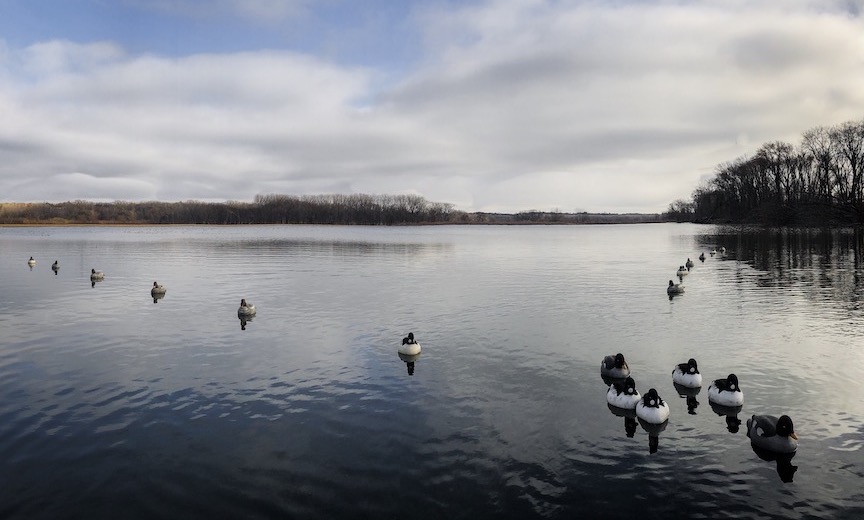
Off in the distance — towards the road — we could hear the four wheeler firing up. Soon enough, we could hear the caravan of vehicles making their way down the trail that he was plowing. Time was of the essence.
We used the remaining window of time to get the hunters from their vehicles to the blind locations, brush them in, get their gear in order, and ready to hunt.
The White Whistlers Arrive
Semi-auto bolts clapped in unison “SHHTUCK! SHHTUCK! SHHTUCK!” while they finished loading up. Seconds later the distant song of whistlers pinged the land, a song so distinctly mythical that Gordon MacQuarrie once penned, “Not for nothing does the goldeneye put his muscular body against those scimitar wings. No duck that flies carries a sweeter song. All ducks are whistlers to some degree, but the goldeneye’s powerful pinions place him in the front row of the celestial choir.”
They’re the Chant de Linos, in classic expression, the prodigy first chair flutist of the orchestra. Their sound is so uniquely unforgettable. Hemingway likened it to ripping silk. A more modern comparison I glean from it is likened to the cadence of rapid, subtle sonar pulses from a submarine at 300 bpm.
One would think that they’d be easily located in the sky with all that rapid pinging, but the exact opposite occurs. Your ears may turn your head to the left, when in fact they’re well off to the right.
This is precisely how the first thirty minutes of the hunt went. All of us would look left from the distant whistling and thirty seconds later an eruption of booms came from the fellas in the Goldeneye Blind.
The whistling from their wings was as constant as the howling winds they effortlessly sang through. After conferring with the others, we agreed I’d better head to the other blind to help chase down any wounded birds. Goldeneyes can take a licking and keep on ticking. I made my way back to the goldeneye blind as another volley went off.
BOOM! BO-BOO-BOOM! I smiled and shook my head to the sounds while getting out of my truck with Jacie, my faithful, four-legged ‘fowler.
“Time to make haste, little girl,” I said to her.
Just as we trudged over to the blind, their guns barked off again. A hooded merganser was down and being carried by the waves past the spread. The direction of the whitecaps naturally brought my eyes to look off in the distance, where The Legend was rowing to pick up a white dot that had been swept onto an ice shelf that had formed the night before.
“How many boxes have you all gone through?” I asked.
“We’re making a good dent in the supply!” was the response.
“Awesome! Looks like you have a few out there,” I said, while watching Legend paddling up the ice shelf to another distant, white dot.
“Bird on the left,” came the call.
“Typical!” I yelled, seeing it not skip a single wingbeat and flying out of range and out of sight as violent snow began blowing horizontally to the left where Legend was paddling back into shore. I walked over to where he landed and helped carry the rowboat back into the woods.
“Legend!” I bowed. “Lots of shooting!”
“Yes, Myth, this is turning out to be a fine morning,” he responded while pulling out two beautiful, drake goldeneyes.
Adaptation
Seeing the blind back to full strength, I put my gun down and picked up the camera to capture a feat I had never before seen accomplished: the boom affixed to Craig’s powerchair.
An A-frame extended out from the back of the chair that supported an arm, which extended along his right shoulder. The front of the arm pinned into his shotgun while the back of the arm had six, 5-pound bench press weights clipped in to serve as a counter balance. This way Craig, who has limited strength to shoulder the gun, could swing on birds. On top of that, Craig’s dexterity inhibits him from pulling the trigger, so he has a bite trigger mechanism that goes from his gun to his mouth — whenever he wants to fire, he simply bites down on the mechanism and the gun goes off.

Positioning him with the decoys was also critical to his success; his shotgun swing is limited to around 10 degrees, so we had to ensure he could swing through the focal point of the spread: the center of the V where the decoy raft of goldeneyes were. Any bird that short stopped, he wouldn’t be able to shoot.
“How are you on your swing? Should we pivot you a little more to account for any that are coming up short?” I asked.
“No, I’m good . . . maybe if we keep seeing it happen, but that hasn’t happened all morning.”
Hard-Fought Success
Three volleys later, and nothing was added except more smiles and jokes from all of us. This was a waterfowler’s dream–a late season hunt where most of the state’s 10,000 lakes were frozen, a frigid winter mix of snow and sleet sustained from the ominous troposphere, and birds were playing with our gunfire. I relished in this for another minute when Craig spied a solo whistler winging in our direction.
We stepped in to turn off safeties and make final inspections. Our eyes confirmed imminence–game on.
Both men squeezed/bit off their first shots at the same time. The string of steel flipped the drake on his back in mid-air. In two wingbeats, he flipped back and kept on. I shook my head in disbelief for another second; thinking in my head that was their best opportunity–they both punished the bird and had nothing to show for it, not even a stray feather.
Craig stretched out an extra degree on his swing and DOWN GOES FRAZIER! DOWN GOES FRAZIER! To our disbelief, the stud goldeneye came tumbling down, but not without more of a fight. Upon hitting the water, it dove. I jumped from my spot behind the blind with my camera, exchanged it for my shottie, and ran for the rowboat.
By the time I could clear the spread with the rowboat, the goldeneye was all but a little submarine with only its black periscope head in sight. The bearing the guys in the blind gave me was just enough for me to get up to it in range, but every time it’d surface, it would dive before I could shoulder my gun. In that brief second, the rowboat would be swept away by the white-caps and I’d be out of gunshot range by the time I could get my hands back on the oars.
After the third attempt, I had to be a little more creative; instead of chasing it, I would wrangle it.
I was determined to flank the drake when he dove by positioning him between the rowboat and the decoy spread. Each time it dove, I had to guess where it was going and try to put myself as close to it as possible while ensuring that it was still on the starboard side, hoping to push it closer to shore.
The logistics of it all was less than stellar, but with some serious mileage accrued while zig-zagging it into shore and a heck of a lot of luck, the wrangling paid off for the guys to finish the bird off. A chorus of cheers erupted from all of us.
Not often does one bird involve the cooperative effort of six guys with varied tasks to get the job done. Not ever has there been a time when duck wrangling was something I witnessed. What struck me the most when I walked the dandy of a whistler into the blind was Craig chiming, “We did it!”
He asked the group if he could keep it for the wall. We all nodded in agreement; we knew this one had quite a story behind it. Therein lies the essence of what separates waterfowling from any other outdoors pursuit. Instead of the big game, upland quarry, or fish that may hang from our wall that “I” killed or caught, chances are — with waterfowl — a collaborative effort from all who sat in the blind.
That is our kinship. This is our heritage. The white whistlers are our song.
Last modified: July 19, 2022


